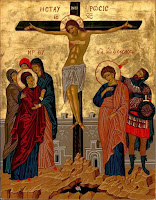 |
| Christ the Redeemer | Rio de Janeiro, Brazil |
Around 200 A.D. Tertullian calculated that March 25, 29 A.D. was the original day of Jesus’ crucifixion. Then, a rabbinic tradition that prophets died on the day of their conception made it the date of the Annunciation to the Virgin Mary. Third, March 25 was also considered the first day of spring and the day when Adam was created.
Whether these dates are historically accurate, I will leave for others to dispute. Here, I only want to devote a few words to reflect on the beautiful symmetry of this supposed coincidence of events. It paints onto the same canvass the very day when 1) God formed man from the dust of the earth, 2) He formed the New Man in the womb of the Virgin, and 3) thirty year later, buried Him back into the earth to await His resurrection.

This confluence of three streams connects man and the earth in profound ways. Indeed, the New Testament witness already points toward this connection. In one of the earliest Christian creeds St. Paul says, “I delivered to you as of first importance what I also received: that Christ died for our sins in accordance with the Scriptures, that he was buried, that he was raised on the third day” (1 Corinthians 15:3-4).
Note that Jesus’ burial in the earth is explicitly confessed. It is no accident that both the Nicene and the Apostolic Creeds include an explicit reference to the burial. This is in keeping with Jesus’ own emphasis. Prior to His passion, He told his disciples, “Truly, truly, I say to you, unless a grain of wheat falls into the earth and dies, it remains alone; but if it dies, it bears much fruit” (John 12:24).
Jesus dies to take away the sin of the world. He is buried to bring forth much fruit. By cleansing the world of sin, He renews not only those people who believe in Him, but the earth itself. God's redemption of humanity is also God's redemption of His entire creation.
Both Peter and Paul integrate this theme into their theology. St. Paul wrote, "…the whole creation has been groaning together in the pains of childbirth until now" (Romans 8:22). Peter, likewise, teaches that Good Friday means, “…we are waiting for a new heaven and a new earth in which righteousness dwells” (2 Peter 3:13).
March 25 is the true and Christian “Earth Day.” It stands in sharp contrast to the secular earth day that was established in 1970.
Today’s eco-religion has, as its central tenet, that humans are the scourge of the earth. It preaches that the earth will only be saved by minimizing man's footprint on the planet. This neopagan religion does everything it can to limit the number of human beings on the earth.
Robert Zubrin, in his excellently researched book, Merchants of Despair, documents this anti-humanistic religion from its “founding prophet,” Thomas Malthus, through Darwin and the bloody 20th century, to Paul Ehrlich’s “population bomb” and the modern green movement.
All of these prophets of doom railed against the biblical mandate for human beings to “be fruitful and multiply and fill the earth and subdue it” (Genesis 1:28). They taught mankind to “…labor with pill and scalpel and syringe to make himself fewer,” as Malcolm Muggeridge once put it. Toward the world, they follow Jean-Jacques Rousseau in rejecting the beneficial work of man. Efforts to protect populations from malaria are opposed overseas while effective means to prevent wildfires are denied in America’s backyard. In every case, anti-humanists prefer to let cultivated land revert to wilderness.
This ostensible love for nature does not translate into any love for the God who created nature. It is especially hostile to the one species created in God’s image. Antipathy for human beings culminates in rejection of the suffering, death and burial of the true Man, Jesus Christ, for the renewal and redemption of all creation.
Christianity confesses the opposite. Starting with the biblical account of creation, God’s creation of Adam was for the earth’s benefit. While the world was created wild and uncultivated, it was not intended to stay that way. God planted a garden (Greek: paradise) and put mankind there to extend it across the whole planet.
Still to this day, as Zubrin documents in his opening chapter, population growth does not impoverish the earth, but enriches it. Historically, as the population grows so does the global standard of living and gross domestic product. Both are fueled by the exponential increase in technology that only humans bring to the planet.
But as much as the birth of children is a blessing for the planet, Jesus’ own conception was the greatest blessing of all! That’s because the salvation of the planet does not depend upon sinful humanity, but upon the Man who is God Incarnate.

The earth is saved not by minimizing this Man’s impact on the world but by maximizing it. The greatest seed that was ever planted in the earth was the body of Jesus. Since it burst out of the grave three days later, the entire earth is being renewed. Even now, as we await the new heaven and the new earth, the greatest thing that can happen to the planet is for the Body of Christ to spread His word and influence across the planet.
What began as a tiny human in the womb of the Virgin will grow into the renewal of the entire universe. That’s why March 25 is the real Earth Day!


